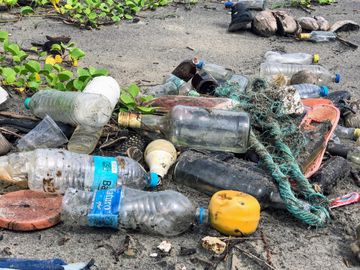Effective climate change mitigation does not only require a rapid reduction in carbon emissions, but also the removal of the excess carbon dioxide from the atmosphere. While the primary focus needs to be on reducing emissions, purchasing carbon removal credits is an effective way to tackle historical emissions as well as other emissions that cannot be eliminated.
But what exactly are carbon removal credits? Where and how can you buy them? How much do they cost? What else needs to be taken into consideration?
We have answered all of the most common questions about carbon removal credits right here.
What is a carbon removal credit?
‘Carbon removal credit’ (CRC) is a term derived from carbon credit. To understand what a CRC is we first have to understand what a carbon credit is.
Carbon credits, also called carbon offsets, are a currency for trading carbon emissions in the carbon market. 1 carbon credit represents 1 ton of emissions not created. If you purchased 5 carbon credits, you are responsible for 5 tons of CO₂ not emitted. They are issued for reductions in emissions (often in the developing world to make them low-cost) and are generally purchased to excuse the buyer’s own emissions.
Transferring that concept to carbon removal - a CRC would represent a currency for trading carbon emission removal. 1 CRC represents 1 ton of emissions removed from the atmosphere. If you purchased 5 CRCs, you are responsible for 5 tons of CO₂ taken back out of the air.
Now you may say: that’s the same thing though, isn’t it? There is a subtle but important difference. We have so much CO₂ in the atmosphere that we can no longer justify our unavoidable emissions by preventing the same amount from happening elsewhere. That is simply no longer enough; we have to prevent all emissions everywhere we can anyways and not use them to sell and justify other emissions. We have to start taking out what we have produced. But for more about the difference between carbon removal and carbon credits, read this article.
Carbon credit markets have organisations such as Verra and Gold Standard that are working to verify the reductions in carbon offsetting projects and selling them. Currently there is no organisation to verify what a CRC is. What would it take to set up a CRC system?
How would a carbon removal credit system work?
The problem with setting up an efficient CRC system is the big differences between the carbon removal projects. These include the time that it takes for the carbon to sequester, the permanence of the carbon removal, and the associated costs. For example, while reforestation offers a cheap solution for emission removal, the solution is not permanent, and it takes the whole lifecycle of a tree to meet its carbon sequestration potential. On the other hand, while the cost of direct air capture and storage is currently high, it leads to permanent carbon removal in a relatively short time span. Even projects that use the same carbon removal methods can have differences between costs, permanence, and sequestration period, adding another layer of difficulty for creating a CRC system.
Reforestation and direct air capture – alongside enhanced weathering, bio-oil storage and other carbon removal solutions – are all required to battle the climate emergency. The problem is that in carbon removal markets where one credit for direct air capture costs way more than a credit for reforestation, different carbon removal methods won’t receive equal support. The supply and demand for CRCs leans strongly towards reforestation and unfortunately, this method alone will not be enough to tackle climate change.
There is a need for a CRC system that will support a wide range of nature-based and technology-based carbon removal solutions without being biassed by the cost differences. To ensure that the system is not biassed towards the cheapest carbon removal methods, we came up with three possible solutions.
Option 1:
The first option is to always communicate what parts of what removal method the CRC was made of, so that it is always transparent what project was supported. E.g. You could purchase a CDR created through forestation and three more created through direct air capture and storage. So that means now you own 4 CDR out of 25% forestation and 75% direct air capture and storage.
With this transparency a CDR created through forestation will not be set the same as a CDR created through direct air capture and storage. On the down side attaching this information to each CDR adds complexity.
Option 2:
Another option is to separate CRCs into categories according to the removal method used. We could have a forestation CRC, a blue ocean CRC, DACS CRC and so on. This option is very similar to the first one except here we look at each CRC from a different category as a different product. E.g. In the previous example you would own 1 forestation CRC and 3 DACS CRC.
Option 3:
Each CRC is made up of equal amounts of all verified removal methods. E.g. The verified methods are DACS, forestation, bio-oil injection and distribution of olivine stone. 1 CRC would be created through 25% removed by each of these methods.
In that case no one could have CRCs consisting only of the cheaper methods. The disadvantages are added complexity. As new removal methods and providers are still emerging, the composition of the CRC would constantly have to be updated and a versioning system would be required.
Regardless of the chosen option, a verification and accounting system is necessary to ensure that the carbon dioxide is actually removed from the atmosphere and not sold more than once.
Where to buy carbon removal credits?
Carbon removal credits don’t exist in that sense yet. But the closest you can get is to buy carbon dioxide removal (CDR) in your name. CDR can be purchased either directly from the producers of the negative emissions or from bundling platforms like Carbon Removed. Purchases can be monthly subscriptions, gift subscriptions or one-off purchases. Customers have the possibility to decide the amount of carbon dioxide that they want to remove. This provides flexibility for people who want to compensate for single activities such as flying and for those who want to match their carbon removal to their personal carbon footprint. After your purchase you will receive a certificate to verify the emissions that you have removed with your CDR purchase, which also lets you know the removal projects you have supported.
The cost of CDR varies depending on the carbon removal projects that are used and how the emission removals are divided between these projects. The cheapest CDR are not always the best as they are less likely to support more expensive carbon removal methods. Finding a credible carbon removal company can be difficult and instead of simply focusing on the pricing, the following factors should be taken into consideration:
- Carbon removal credits (CRCs) and carbon dioxide removal (CDR) are not the same thing as carbon credits. Make sure that your money is used to remove carbon from the atmosphere instead of offsetting emissions.
- Are the carbon removal projects verified? To prove removal and avoid double selling credits, it is important that carbon removal projects are verified.
- What carbon removal methods does the company support? Effective climate mitigation requires carbon removal companies to support multiple carbon removal methods. Make sure that your money goes towards different projects.
Carbon Removed is a good example of a company that ticks all the boxes. Our focus is solely on carbon removal and our partners have gone through a strict verification process. Buying carbon removal from Carbon Removed will also simultaneously support reforestation, direct air capture, enhanced weathering, and bio-oil. By doing so we are offering an effective way to remove emissions through both nature-based and technology-based solutions.
Conclusion
The purpose of carbon removal credits is to remove carbon from the atmosphere instead of simply offsetting future emissions. While carbon removal does not make up for reducing emissions in the first place, it is crucial for tackling the climate emergency. It is also important to make sure that carbon removal supports a wide range of different nature-based and technology-based solutions as the permanence and sequestration period vary a lot between different carbon removal methods. The cheapest solutions alone will not be effective enough to address the climate emergency and the best way to ensure that different solutions are supported is to buy carbon removal credits from businesses that remove carbon using multiple different methods.



